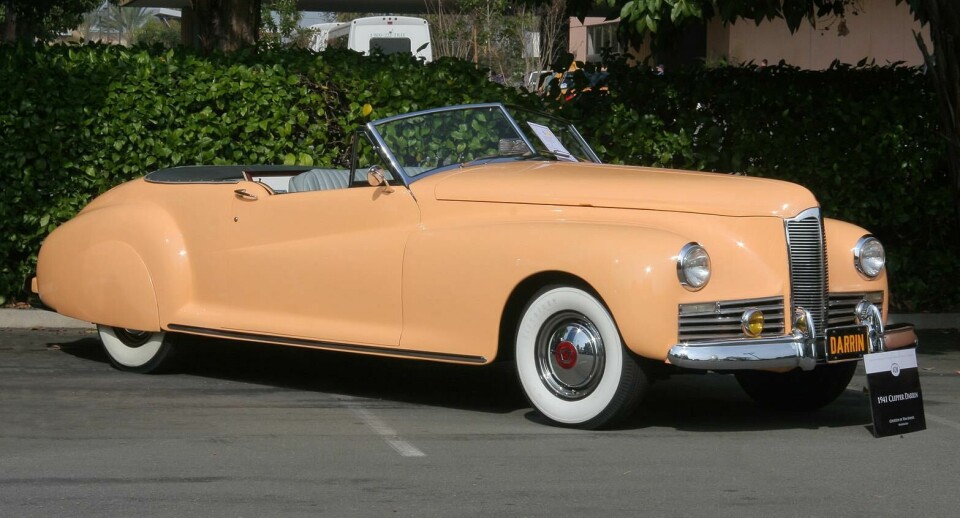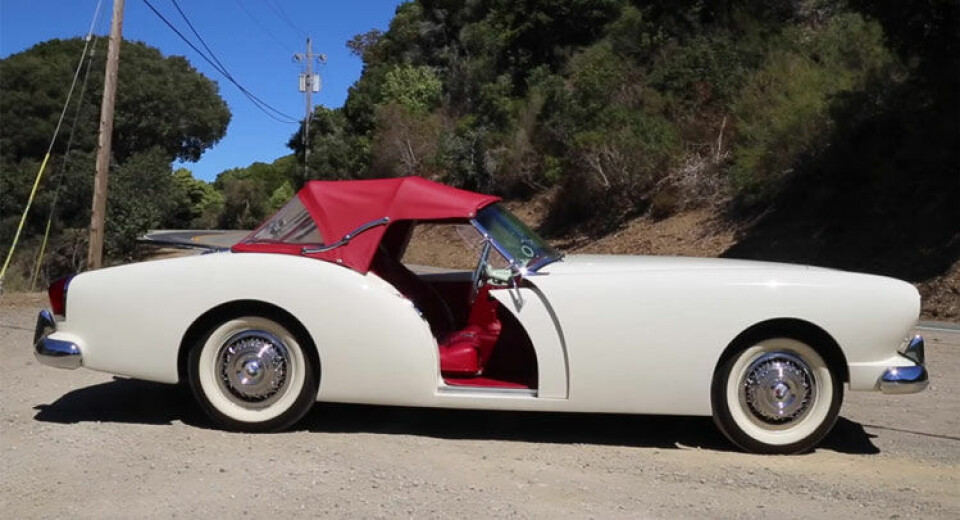
Concept Car(s) of the Week: The Darrin Roadsters
Dutchman Darrin’s search for the ‘Holy Grail’ of sports cars
The history of the automobile is crowded with colourful, larger-than-life personalities. One name that should be included in everyone’s top ten, though, is Howard ‘Dutch’ Darrin, a gifted designer and inventor who worked for a host of classic mid-century marques. Darrin flew as a fighter pilot for the French in one World War and trained pilots for the Americans in the next. In between he ran a coachworks in Paris, then in Hollywood, catering to old money and the new royalty: movie stars.

The 1941 Packard Clipper Darrin – an instant classic, with Darrin’s signature character line across the fender and door
In the 1930s Darrin would work for Packard and other marques, creating custom and limited-run cars. His styling trademark was a swooping line that leapt across the front fender and swept across the door panels to terminate in the curve of the wheel bulge at the rear fender.
Darrin had planned to manufacture and sell his own car after the World War II, but ran into material shortages. He then connected with industrialist Henry J. Kaiser, who had teamed up with Joseph Frazer, of the former Graham Paige marque, to resurrect the defunct automaker and form a new company, Kaiser-Frazer.

Kaiser-Frazer crests. Though one company, different nameplates were designated for different cars. Frazer marketed the more luxurious offerings
Kaiser and Darrin had an immediate connection, not only through their love of planes, boats and cars, but also – of all things – metallurgy. Darrin had, in the course of his coachbuilding business in Paris, developed innovative metallurgical techniques and a special aluminium alloy called Alpax. Kaiser and Darrin could speak with intimate knowledge of the potential of various types of metal, and with great enthusiasm for emerging materials (made possible because of the war) like aluminium, lightweight steel and fibreglass.
Darrin was soon hired as a consultant and had a great impact on the new postwar Kaiser sedans. But he grew increasingly irritated with Kaiser’s staff watering down his designs. The relationship, which started with such purpose and hope, soon deteriorated.
Part of the problem was Darrin himself. He could be mercurial and temperamental on a good day, and things often would slide downhill from there. He was also accustomed to a coachworks clientele, whereas Kaiser was building for the masses. Finally, in 1946, Darrin resigned, to no one’s surprise and Henry Kaiser’s relief.

Kaiser Manhattan – a Darrin-designed, premium sedan that couldn’t save Kaiser
But Kaiser brought Darrin back for more projects in 1948. The Darrin-designed Kaiser Manhattan, brought to market in 1951, was a handsome and dapper premium sedan that is now considered a mid-century American classic. Kaiser now turned his attention to his long-awaited car for the everyman. Darrin was given a clean slate for designing, but, once again, a daring design was tamed by Kaiser’s in-house staff. Darrin once again resigned and the design of a boxy, but functional, car proceeded without him. The little Kaiser, named the Henry J, was launched in 1951 and proved a moderate success.

Kaiser Henry J – a car for the masses, which underpinned the Darrin
Darrin couldn’t get over the loss of the Henry J to less competent designers, and stewed about the design for years. He too dreamed of an everyman’s car – but a sports car, not a sedan. He longed for a car that could be as simple as the Henry J but with a sleek, lightweight body, and a suspension that made it fun to drive.
Finally, on his own initiative, he purchased a Henry J chassis, covered it with a wooden buck and sculpted a clay model. He then contracted to have a fibreglass body made from the model and fitted it over the frame of the little Kaiser. After finishing the detailing and a coat of paint, he invited Kaiser over to have a look, without telling him what it was.

Dutch Darrin working on the clay model of the Darrin sports car
Kaiser was shocked to see a sports car awaiting him in Darrin’s shop. He upbraided the designer for wasting his and the company’s time on such a project. Kaiser was about everyday cars, not vanity projects such as roadsters. “We are not in the business of selling sports cars!” he roared.
But Darrin stood his ground. He noted that the project was done on his own time and with his own money, and that Kaiser should give people an option to the standard, boxy, Henry J. Additionally, Darrin claimed, if Kaiser didn’t produce the car, he would find a way to build it himself.

Alyce and Henry J. Kaiser on their wedding day
At this point, Kaiser’s new (and much younger) wife, who had come along to see the car, weighed in with her opinion. “This is the most beautiful thing I have ever seen,” she said. “I don’t see why you aren’t in the business of building sports cars. I don’t think there will be many automobile companies that won’t go into the sports car business after seeing this car.”
Darrin had found his project’s saviour.

Alyce Kaiser – the face that launched 453 sports cars
Soon, a prototype was in the works and by the autumn of 1952 the little car, called the Kaiser-Darrin 161, was shown at the Petersen Motorama in Los Angeles to great acclaim and excitement. Production was promised for 1953.
However, it was delayed – and in the meantime, the Darrin, which had beaten the Chevrolet Corvette to the attention of the public by a few months, had fallen behind Chevrolet’s sporty car, which managed to crawl into production with 300 handbuilt units in that model year. Still, the Darrin held a place in the public’s imagination and garnered lots of attention when it was finally introduced.

Two Kaiser Darrins in good company at a recent concours
A walk around the Darrin shows why it was such a hit. A low-slung open-top sports car, its sculpted body seemed longer than it actually was. The curvaceous fibreglass mask featured a slightly raised, shell-shaped grille that soon earned the nickname ‘kiss-mouth’. The characteristic Darrin swoop was integrated into the fenders. The whole assembly looked of-a-piece, as if carved from a single block of fibreglass. The car was offered in four lacquer colours – enamel paints weren’t an option as the fibreglass couldn’t survive the heat of the baking process.

A Kaiser Darrin in its original soft green colourway
The cockpit was tiny, with sliding doors that disappeared into the front fender. An imperfect system at the best of times, the rollers on the doors proved ineffective, although Darrin would not hear of an alternate door configuration – he hated traditional doors. The sliding doors made for a very narrow entry, and it was usually best to step into the car and then slide down into the seat. The cockpit was covered with a three-position top – side curtains were available in lieu of windows.

The Darrin’s interior – note the padded dash; safety first, despite lacking seatbelts
The engine, a source of considerable controversy within the Kaiser company, ended up being a low-powered Willys six-cylinder, after plans for a V8 proved impractical. The car was fun to drive, although it suffered from terminal understeer in hard cornering situations. It was slow, too; 0-60mph took about 15 seconds and the top speed was a modest 95.

A tired Darrin yawning after a hard day at the car show.
That’s a Willys powerplant in the engine bay
But to Darrin it looked like the ‘Holy Grail’ of his career was at last within reach. Kaiser began marketing the car as part of its forthcoming lineup, noting its sporty looks and design by “Darrin of Paris” (Paris in this case being in, ahem, Santa Monica…).
The little car began to build a following, but production kept getting delayed and did not ramp up until August 1953 – two months behind the Corvette. By that time Kaiser was teetering on the brink of insolvency. Hopes that the Darrin could act as a ‘halo car’ to attract customers to Kaiser’s more everyday offerings proved overly optimistic. Kaiser dealers didn’t want to order the Darrin, especially with winter coming on. One entire shipment of 50 Darrins spent the winter of 1953-54 trapped in a snowbank in Toledo, Ohio, where a freak snowstorm crippled the city for weeks.

Rear three-quarter view shows handsome massing and proportions
By spring of 1954, Kaiser saw the handwriting on the wall. He ordered that production of the Darrin stopped at its manufacturing plant, where the lease was about to expire. He had no plans to move the tooling elsewhere. A total of just 453 Darrins were produced. Kaiser’s resources had to be concentrated on the best-selling models… and even that was not enough. The company would cease automotive operations in 1955 and focus on Jeep production, moving the remnants of its automotive operations to Argentina.

Was the Kaiser Darrin sports car perfection? No, but it was very close in its day…
Dutch Darrin was shattered. His dream of the everyman’s sports car seemed at an end. He bought as many of the remaining cars as he could, including the frozen 50 from Toledo, and brought them all to Santa Monica to sell as his own Darrin marque. These were outfitted with more powerful engines, including some with the Cadillac 303ci V8. Performance was not a problem then. But the end was certain, at least as far as the Kaiser connection was concerned.




